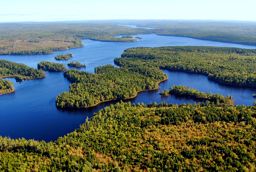South Panuke Wilderness Area extends from Highway 103, near Chester, north, to Panuke Lake. Two disjunct parcels lie further north on either side of Panuke Lake. The wilderness area straddles three counties: Halifax, Hants, and Lunenburg.
Nearly 30 km long, Panuke Lake partly bisects western Nova Scotia from the central part of the province. The lake and developed lands to the north between Windsor and Ellershouse create a barrier to terrestrial wildlife movement between central and western Nova Scotia. By protecting lands south of Panuke Lake, the wilderness area maintains a biodiversity “land bridge” that helps keep western Nova Scotia ecologically connected to the rest of the province. Wide ranging species, such as endangered mainland moose and pine marten, will benefit from this protected natural corridor.
Much of this wilderness area consists of hills, ridges, and hummocks. Mature red spruce is widespread, sometimes mixed with hemlock or white pine. Black spruce occurs on poorly drained sites. Parts of the southern portion of the wilderness area were logged in recent years, while the northern portions, especially the two disjunct parcels on either side of Panuke Lake, support extensive older forest. This wilderness area provides a good opportunity to restore a regionally significant and relatively large patch of older forest.
South Panuke Wilderness Area protects significant portions of the Canaan and East River watersheds, including lake and stream habitat for brook trout and potential Atlantic salmon recovery. It also fills a significant gap in representation of the South Mountain Rolling Plain natural landscape in the provincial protected areas network.
These lands are part of a traditional Mi’kmaq travel route between the Bay of Fundy and Atlantic coast. The area continues to be used for hunting and fishing today. Visitors can still follow traditional canoe routes and old portages, and overnight at secluded beach campsites. Much of the area is accessible from major forestry roads, as well as the Chester Connection Rails-to-Trails.
The boat launches at the southern ends of Timber, Panuke and Connaught lakes may be accessed by vehicle. Neither these lakes nor the roads to these boat launches are part of the wilderness area.
A 7 km section of off-highway vehicle trail passes through the wilderness area, along old forest access roads between Canaan and Timber Lake. This section of trail is managed by the All-terrain Vehicle Association of Nova Scotia (ATVANS) under an agreement with Nova Scotia Environment. Bicycle use is also permitted on this trail.
One campsite lease is located within the wilderness area.
A transmission line operated by Nova Scotia Power Inc. just north of Highway 103 is not within the wilderness area.
South Panuke Wilderness Area was designated in 2015. A 349 hectare parcel at Little St. Margarets Bay Lake was added in 2023.


